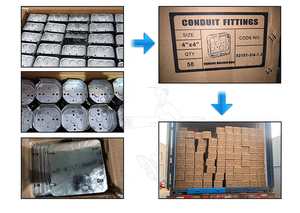(1378 products available)






























































































































































































Sizing a ductwork system is essential to ensure its efficiency and proper functionality. The size is determined by the volume of air that needs to be circulated, the pressure required to move the air, and the type of space being conditioned.
Rectangular ductwork is the most commonly used type of ductwork, and it comes in multiple sizes to fit the needs of different HVAC systems. Rectangular ductwork sizes can be divided into the following types based on their size:
Rectangular ducts with dimensions of 25x12 inches or smaller are considered small. They are used in residential buildings and small commercial spaces to provide conditioned air to each room. These ducts are suitable for systems with low air volume requirements.
Ducts with dimensions ranging from 25x13 inches to 41x23 inches are considered medium-sized. These ducts are commonly used in medium-sized commercial buildings, such as offices, retail stores, and restaurants. They can handle higher air volume and pressure requirements than small ducts and are suitable for conditioning larger spaces.
Ducts with dimensions larger than 41x24 inches are classified as large-sized. They are typically used in industrial facilities, large commercial buildings, and high-rise properties. Large ducts can move a significant volume of air at high pressure levels, making them suitable for conditioning large open spaces. They are often part of complex HVAC systems with multiple zones and specialized air distribution requirements.
Rectangular ductwork comes in standard rectangular duct sizes that are commonly used in the industry. These sizes are based on the dimensions of the duct's cross-section. Standard sizes range from 6x3 inches to 120x48 inches. Standard rectangular ductwork is typically fabricated from galvanized steel, aluminum, or fiberglass. It is used in both residential and commercial applications, providing a cost-effective and efficient solution for air distribution.
In some cases, common rectangular duct sizes may not meet the specific requirements of a project. In such cases, custom-sized rectangular ductwork is designed and fabricated. Custom ducts are available in sizes that deviate from the standard dimensions to meet unique space constraints and air distribution needs. They are typically used in high-end residential properties, specialty commercial spaces, and industrial facilities with specific air handling requirements.
Rectangular ducts are used in AC and heating systems. The ducts move air between the HVAC components and the spaces being conditioned. Ducts are used for both supply and return air. The size of the ducts should be appropriate for the air volume to allow for efficient airflow.
Rectangular ductwork is commonly found in commercial buildings. The ducts distribute conditioned air to various spaces, such as offices, retail stores, and restaurants. Proper sizing is essential to ensure consistent and adequate airflow in large commercial spaces.
Rectangular ducts are also used in residential buildings to distribute air from heating, cooling, and ventilation systems to different rooms. They are commonly installed in walls, ceilings, or floors. Proper sizing of the ducts is crucial to ensure efficient and uniform airflow in homes.
Rectangular ductwork is widely used in industrial settings to distribute air in factories, warehouses, and manufacturing facilities. These applications require large-scale ductwork to maintain indoor air quality, provide ventilation, and regulate temperature. Proper sizing is crucial for the efficient operation of industrial HVAC systems.
Rectangular ducts are also used in specialized environments, such as clean rooms, laboratories, and data centers. These environments require precise control over temperature, humidity, and air quality. Properly sized ductwork is essential to ensure the optimal performance of HVAC systems in these critical spaces.
In some cases, rectangular ducts may be customized to fit specific design requirements. Custom ductwork may be required in spaces with limited installation space, such as retrofit projects or architectural designs with unique constraints. Proper sizing and design are crucial for the effective and efficient operation of custom ductwork.
When buying rectangular ductwork for sale, buyers should consider the following factors:
Q1: What is the standard rectangular duct size?
A1: There is no single standard size, but common sizes include 6 x 6 inches, 8 x 8 inches, 10 x 10 inches, 12 x 12 inches, and so on up to several feet in width and height. The exact size needed depends on the airflow volume of the system and the available space.
Q2: Why are transitions between different-sized ducts needed?
A2: Ducts that suddenly change size can cause airflow resistance and noise. Gradual transitions help the air flow smoothly from one duct to another, improving system efficiency and reducing noise.
Q3: What factors should be considered when selecting duct material?
A3: Important factors to consider when selecting duct materials include the system's airflow requirements, available space, and budget. In addition, certain materials are more suitable for different applications. For example, galvanized steel is a very common choice for commercial and industrial HVAC systems because it is durable and fire-resistant.
Q4: What is the ideal maximum velocity for air traveling through a duct?
A4: The maximum recommended air velocity in the duct depends on several factors, including the size and shape of the duct, the type of material used, and the specific application. However, as a general rule, it is recommended to keep the air velocity below 1500 feet per minute to reduce noise and airflow resistance.
Q5: How to prevent air leakage in rectangular ducts?
A5: Air leakage can be prevented by ensuring that all joints and seams are properly sealed with duct tape, mastic, or other approved sealing materials. Regular maintenance should also be performed to check for and repair any leaks that may develop over time.